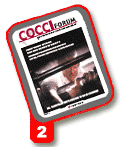Combating ResistanceVaccination seeds houses with oocysts that are sensitive to commonly used in-feed coccidiostats
Poultry producers confronting
resistance to in-feed coccidiostats
can minimize the problem
by incorporating coccidiosis vaccination
into their management plan, says
poultry veterinarian Dr. Linnea J.
Newman. Changes Oocyst Population
Coccivac-B, Newman explains, is a live
vaccine produced with oocysts that
were isolated before currently used
coccidiostats were even developed.
Consequently, birds that receive this
vaccine shed oocysts that are sensitive
to the in-feed coccidiostats widely used
today by poultry producers. Clear EvidenceAs evidence, Newman points to
She also cites trials conducted by Dr. Harry D. Danforth of the USDA (see feature on page 6), which further demonstrate that vaccinating with Coccivac-B renews the sensitivity of an on-farm coccidial population to the ionophore salinomycin, the most widely used coccidiostat in the United States.
Next, sensitivity to salinomycin was tested. One group of specific- pathogen-free (SPF) birds was challenged with oocysts from the vaccinated houses, and another group of SPF birds was challenged with oocysts from the ionophore-treated houses. During the challenge, all birds received 60 ppm of salinomycin. Weight Gain ImprovedComparison of the two groups revealed much better weight gain in the birds
More recent studies by Danforth indicate that vaccination can not only restore the sensitivity of oocysts to coccidiostats, but that it changes the composition of mixed species oocysts in the field and their ability to cause intestinal damage, Newman says. For instance, an aggressive strain of Eimeria tenella and a moderately pathogenic E. maxima were isolated from litter samples collected from a farm at a large broiler integrator. After the samples were collected, a new flock was
The mixed-species oocyst population from each sample was isolated and used to challenge 10-day-old SPF test birds fed nonmedicated or salinomycin- medicated feed. Six days after the challenge, the birds were weighed and intestinal lesions were recorded. “Following vaccination with Coccivac-B, the aggressive E. tenella population had virtually disappeared,” Newman says. Before vaccination, the E. tenella was considered very aggressive and created high lesion scores, even in salinomycin-medicated birds. It should also be noted that 3-Nitro (arsenelic acid) had to be used routinely to augment the ability of ionophore coccidiostats to control E. tenella, she says. Lesion Scores Improve
After immunization, lesion
scores for the middle and
upper intestine due to E.
maxima and E. acervulina
had improved in salinomycin-
medicated birds,
which indicates that vaccination
had an impact on
these species of Eimeria
and that each species had
improved sensitivity to salinomycin
after vaccination.
Source: CocciForum Issue No.2, Schering-Plough Animal Health. |








 © 2000 - 2021. Global Ag MediaNinguna parte de este sitio puede ser reproducida sin previa autorización.
© 2000 - 2021. Global Ag MediaNinguna parte de este sitio puede ser reproducida sin previa autorización.